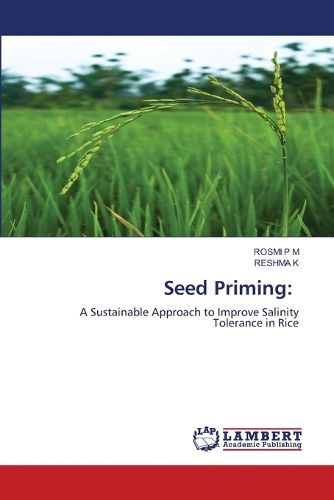Readings Newsletter
Become a Readings Member to make your shopping experience even easier.
Sign in or sign up for free!
You’re not far away from qualifying for FREE standard shipping within Australia
You’ve qualified for FREE standard shipping within Australia
The cart is loading…






This title is printed to order. This book may have been self-published. If so, we cannot guarantee the quality of the content. In the main most books will have gone through the editing process however some may not. We therefore suggest that you be aware of this before ordering this book. If in doubt check either the author or publisher’s details as we are unable to accept any returns unless they are faulty. Please contact us if you have any questions.
The most consumed main dietary crop worldwide is rice, which is also a significant source of fiber, energy, minerals, vitamins, and other biomolecules. Environmental pollutants and abiotic stress influence seed germination, emergence, and agricultural output. Salinity can affect agricultural output in dry and semi-arid regions. Underneath salt conditions, seed priming has the benefit of displaying steady and faster germination price, seedling vigor, and crop development below adverse circumstances, as well as overcoming them from dormancy. The present study explored various seed priming techniques in rice varieties like Mallikuruva and Mattathriveni to standardize suitable treatment and to examine its effects on growth parameters under saline environment. The rice seeds had been primed with different seed priming approaches viz., hydropriming, osmopriming, redox priming, chemical priming, hormonal priming and they were germinated under salinity stress of various concentration of NaCl. Growth attributes were calculated and Salt stress was evaluated based on visual symptoms according to the Standard Evaluation System (SES) score. All the priming techniques show promising results.
$9.00 standard shipping within Australia
FREE standard shipping within Australia for orders over $100.00
Express & International shipping calculated at checkout
Stock availability can be subject to change without notice. We recommend calling the shop or contacting our online team to check availability of low stock items. Please see our Shopping Online page for more details.
This title is printed to order. This book may have been self-published. If so, we cannot guarantee the quality of the content. In the main most books will have gone through the editing process however some may not. We therefore suggest that you be aware of this before ordering this book. If in doubt check either the author or publisher’s details as we are unable to accept any returns unless they are faulty. Please contact us if you have any questions.
The most consumed main dietary crop worldwide is rice, which is also a significant source of fiber, energy, minerals, vitamins, and other biomolecules. Environmental pollutants and abiotic stress influence seed germination, emergence, and agricultural output. Salinity can affect agricultural output in dry and semi-arid regions. Underneath salt conditions, seed priming has the benefit of displaying steady and faster germination price, seedling vigor, and crop development below adverse circumstances, as well as overcoming them from dormancy. The present study explored various seed priming techniques in rice varieties like Mallikuruva and Mattathriveni to standardize suitable treatment and to examine its effects on growth parameters under saline environment. The rice seeds had been primed with different seed priming approaches viz., hydropriming, osmopriming, redox priming, chemical priming, hormonal priming and they were germinated under salinity stress of various concentration of NaCl. Growth attributes were calculated and Salt stress was evaluated based on visual symptoms according to the Standard Evaluation System (SES) score. All the priming techniques show promising results.